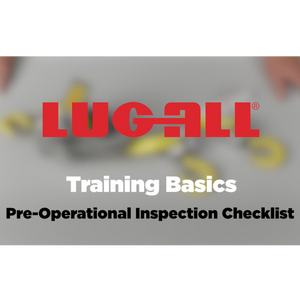Lug-All Pre-Operational Inspection

Lug-All Come Along Ratchet Winch Hoists have always been designed and produced to high standards. High-quality materials and precision construction ensure that Lug-All winch hoists deliver consistent performance for many years. To protect the longevity of your Lug-All, it is important to perform routine inspections and maintenance.
Inspection Checklist
Before using a Lug-All winch hoist, you should perform a simple pre-operational inspection following these steps. If the hoist fails any of the inspection points, it should be removed from service. Damaged winch hoists can be sent to Lug-All for repair or repaired with replacement parts available from the Lug-All online store.
- Inspect the hooks for deformation, cracks, and wear.
- Check the operation of the latches.
- Inspect the full length of the web strap for fraying, melting, chemical damage, abrasive wear, cuts on the face or edges of webbing, or any other damage.
- Check the ratchet teeth for gouges, burred edges, or any other physical damage.
- Check the entire winch hoist for bent or broken metal parts.
- Check the pawls for bends, cracks, or other damage.
- Check the integrity of the springs.
- Operate the u-frame and verify that the u-frame pawl contacts the main frame pawl spring correctly and does not miss the spring.
- Test operating functions, such as lowering, lifting, and free release.
- For web strap hoists, check the handle for a broken stress link. For wire rope hoists, check the handle for bending or deformation. A broken stress link or bent handle indicates the hoist has been overloaded.
Operation Inspection
The Lug-All winch hoist has three operation modes: tensioning, backing off, and free release. To test the tensioning function, rotate the reverse lever toward the drum to engage the u-frame pawl against the ratchet teeth. Operate the handle as required to apply the proper tension.
To test the backing of function, rotate the reverse lever away from the drum to move the u-frame pawl away from the ratchet teeth. Move the handle until the u-frame pawl engages the main frame pawl spring. Additional handle pressure in the same direction will release the main frame pawl. Ease off the handle and the load will lower one tooth at a time.
To test the free release function, rotate the reverse lever away from the drum to move the u-frame pawl away from the ratchet teeth. Press the trigger to hold the main frame pawl away from the ratchet teeth.
Maintenance
Some corrosion is normal for Lug-All winch hoists used in outdoor conditions. Shafts and other moveable parts can be lubricated with lightweight lubricants or penetrants, such as WD-40 or similar products. Keeping the hoist lubricated will allow it to work more easily and freely. Be careful not to spray lubricant on the strap of Lug-All web strap hoists, as it can compromise the dielectric properties and damage the strap material.
By inspecting your Lug-All come along ratchet winch hoist regularly, you help protect your equipment from unexpected maintenance issues in the future. Lug-All winch hoists are manufactured to strict quality standards, but poor maintenance can cause even the best products to stop working properly. In extreme cases, lack of maintenance can cause equipment to fail entirely—possible in the middle of a task. While Lug-All uses several safety features to help keep you safe, unexpected equipment failure can put your safety at risk. Keeping up with inspections and maintenance protects not just your equipment, but also yourself.
